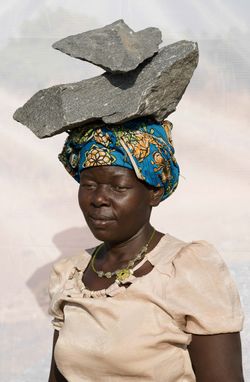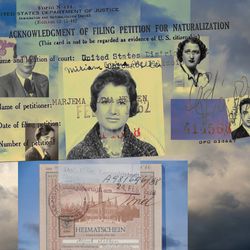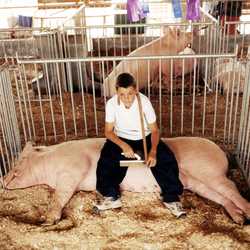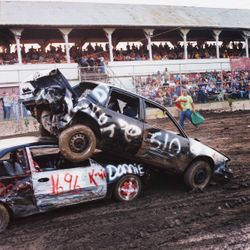
HeadStrong: The Women of Rural Uganda
HeadStrong combines portraiture with first-person biographies of a cross-section of working women in rural Uganda. These women share their stories of war, perseverance, family commitment, and faith.
Knowing each woman had a compelling story to tell and aware of my outsider status, I partnered with Beatrice Lamwaka, an award-winning Ugandan author. Lamwaka interviewed each portrait subject in her local dialect and then wrote a narrative accompanying the photo. Dr. Stella Nyanzi, an exiled Ugandan writer, human and queer rights advocate, feminist, medical anthropologist, and public health scholar, has written an Introduction to HeadStrong.
A safe place was created by selecting a mosquito netting backdrop that separated the women from their chaotic surroundings. The fabric's semi-transparency revealed each woman’s environment while illuminating them physically and metaphorically.
I encouraged each woman to express herself through her demeanor and personal choice of clothing and accessories. Their direct gaze powerfully conveys their sense of self as they present themselves to the camera, thus allowing the viewer to recognize their agency.
The HeadStrong portraits become more impactful when paired with the shared details of the women's lives through their oral histories of survival, tenacity, and hope. Together the photographs and the biographies paint a realistic picture of how social circumstances, which favor patriarchy, perpetuate hardships for many women, limiting their educational opportunities and financial stability for them and their children.

Cat's Cradle
My parents were Holocaust survivors.
My maternal grandmother witnessed the spread of Nazism in Poland: a widow, she left Danzig on the eve of WWII with her three children, traveling to the only country she knew would allow them to enter, Palestine.
My father, aged 19, and his older brother Max left Vienna after Kristallnacht (Night of Broken Glass) on an overcrowded boat that traveled down the Danube to the Mediterranean and ultimately to Palestine. Tragically, their mother and sister decided to remain in Vienna, thinking that they had nothing to fear; they died in Theresienstadt's concentration camp.
My parents’ struggles as Jewish refugees and immigrants created a strong emotional bond between them that I could never comprehend as a child.
When my father died in 2014, I came across original documents in several languages that they transported across many borders: photographs, birth certificates, school records, entry visas, etc. These documents anchored my parents’ history and underscored their tenacity and courage to migrate, adapt, and prosper in Palestine, later Israel, then Canada, and finally in the United States with their two children in tow.
How could I embrace and fully comprehend this familial history of immigration and cultural adjustments when memory and time shift the truth? Cat's Cradle provides the opportunity to explore this conundrum. I wanted to delve into each parent's history as well as my own by illustrating the common threads of their journeys toward a new life. Their need to emigrate was not unlike the needs of millions of people embarking on migration journeys today.
It's my hope that “Cat’s Cradle” might empower other first and second-generation immigrants to explore their own family journeys while there is still time to solicit answers.
By combining multiple images of skies taken on different continents at various times, I hoped to capture the transience of Time and Place. Their documents add a historical dimension, serving as evidence of their lives and struggles. I chose photographs from our family albums that conjure an idealized past to illustrate both their identity and humanity.
Like the childhood game for which it is named, Cat's Cradle enables one to weave a singular, circular thread into multiple enigmatic stories, revealing tales about survival, tenacity, loss, and love.

Till the Cows Come Home: County Fair Portraits
County Fairs have been part of the American way of life for more than 160 years and have existed because of the family farmers that choose to participate in the agricultural arena of these fairs. Yet, as family farms disappear at the rate of hundreds per month, family-based farming is struggling to retain its relevancy in rural farming communities and hold on to it’s disappearing cultural lifestyle.
My objective was to capture the essence of this lifestyle through portraits of the participants, as well as the fruits of their year long labor. Every summer since 1998, from July to September I sought out these three to ten day events hoping to document in portraits and still life’s, an agricultural tradition that may be in its sunset years. Aware that others have looked through a lens at similar subject matter, I did not want to beautify the experience or trivialize it through sentimentality. My love of irony, of circumstance, and of the candor of the moment, guided my photographic journey. I hope that when county fair participants look at these photographs they can say to themselves, “Yes, this is truly how it is.”

Smash'em Crash'em
Before extreme sports, there was Demolition Derby, a quintessential American populist pastime celebrating the deliberate destruction of America's 21st-century symbol of mobility, the automobile.
Dangerous, unpredictable, and even gravity-defying at times, anyone with a "derby car" and a desire to create havoc can participate. A derby reeks of bravado and irony because of its dangerous, unpredictable, even gravity-defying nature. What is feared the most in the real world – the terrifying, ear-splitting sound of cars colliding – is applauded, encouraged, and sanctified in the derby ring.
Hours are spent in anticipation: passing vehicle inspection, rooting for the best-decorated vehicle, and finally, the wait between matches seems interminable as wrecks from each heat are hauled off to the auto graveyard so the next set of vehicles can participate.
It can take months to prepare a car for competition and only minutes to eradicate it. Strapped into stripped-down shells of cars, competitors purposefully attack and destroy each other's vehicles with impunity, hoping to survive the destruction by piloting the last car moving to become the winner of a heat. The technique is simple to grasp but difficult to master: aim for a target, hit the gas peddle at full throttle, and move in reverse so you don’t destroy your engine. Even the most intrepid competitor will rarely risk certain immobility by using their front end to smash into their competitors.
Buoyed by a grandstand audience inured to flying mud, noise, smoke, and diesel fumes, the heats slowly progress from small 4-cylinder wrecks to V-8 clunkers until the best of the heats enter a final "smash-off" to become champion destroyers.
